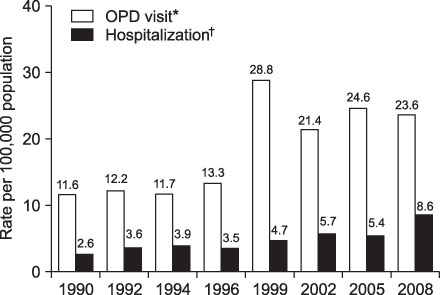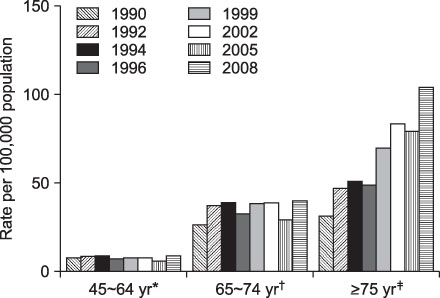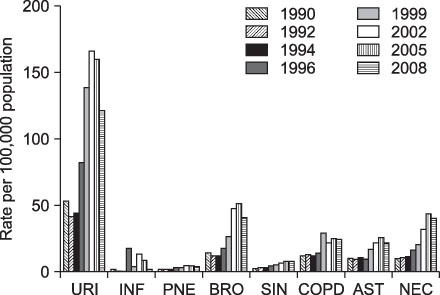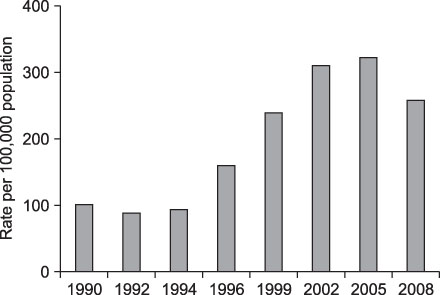Tuberc Respir Dis.
2011 Apr;70(4):307-314.
Trends and Factors in Health Care Utilization of Patients with Chronic Obstructive Pulmonary Disease in Korea: A Nationwide Survey from 1990 through 2008
- Affiliations
-
- 1Department of Pulmonary and Critical Care Medicine, Asan Medical Center, University of Ulsan College of Medicine, Seoul, Korea. ymoh55@amc.seoul.kr
- 2Korea Institute for Health and Social Affairs, Seoul, Korea.
- 3Asthma Center, Asan Medical Center, University of Ulsan College of Medicine, Seoul, Korea.
Abstract
- BACKGROUND
Chronic obstructive pulmonary disease (COPD) is a major cause of death and disability worldwide and one of the most prevalent diseases in Korea. We examined trends and risk factors of health care utilization for COPD in Korea.
METHODS
We retrospectively analyzed the database of Patient Surveys from 1990 through 2008, which were nationwide surveys of health services utilization through outpatient department (OPD) visits and hospitalization. Physician-diagnosed COPD patients whose ages were 45 years and older were included.
RESULTS
OPD visits and hospitalization of COPD patients between 1990 and 2008 were estimated to be 68,552 and 17,774 persons, respectively. Trends in OPD visits and hospitalization for COPD significantly increased from 1990 through 2008 (p=0.019, p=0.001, respectively). The increment rate for OPD visits was 2.0 fold over those years; for hospitalization it was 3.3 fold. Risk factors for OPD visits for COPD were male gender (odd ration [OR], 1.41; 95% confidence interval [CI], 1.39~1.43), those aged 65 years and older (OR, 1.50; 95% CI, 1.47~1.53), residential area other than a metropolis (OR, 1.08; 95% CI, 1.07~1.010) and access to a physician's office (OR, 1.17; 95% CI, 1.14~1.21). Risk factors for hospitalization were male gender (OR, 2.15; 95% CI, 2.07~2.23), those aged 65 year and older (OR, 2.86; 95% CI, 2.72~3.00), residential area other than a metropolis (OR, 1.98; 95% CI, 1.90~2.07) and access to a hospital (OR, 2.88; 95% CI, 2.59~3.22) (p<0.001, both).
CONCLUSION
Health care utilization for COPD subjects increased from 1990 to 2008. Risk factors for the utilization were male gender, older age, and residential area other than a metropolis.
Keyword
MeSH Terms
Figure
Reference
-
1. Rabe KF, Hurd S, Anzueto A, Barnes PJ, Buist SA, Calverley P, et al. Global strategy for the diagnosis, management, and prevention of chronic obstructive pulmonary disease: GOLD executive summary. Am J Respir Crit Care Med. 2007. 176:532–555.2. Lopez AD, Shibuya K, Rao C, Mathers CD, Hansell AL, Held LS, et al. Chronic obstructive pulmonary disease: current burden and future projections. Eur Respir J. 2006. 27:397–412.3. Korea National Statistical Office. Annual report on the cause of death statistics 2008. 2009. Daejeon: Korea National Statistical Office.4. Kim DS, Kim YS, Jung KS, Chang JH, Lim CM, Lee JH, et al. Prevalence of chronic obstructive pulmonary disease in Korea: a population-based spirometry survey. Am J Respir Crit Care Med. 2005. 172:842–847.5. Shin HS. The evolution of health and utilization inequalities over time. Health Welf Policy Forum. 2009. 149:26–35.6. Bernstein AB, Hing E, Burt CW, Hall MJ. Trend data on medical encounters: tracking a moving target. Health Aff (Millwood). 2001. 20:58–72.7. Doh SR. Changes of medical utilizations and issues on health care policies. Health Welf Policy Forum. 2005. 102:65–76.8. Prescott E, Vestbo J. Socioeconomic status and chronic obstructive pulmonary disease. Thorax. 1999. 54:737–741.9. Park MJ, Choi CW, Kim SJ, Kim YK, Lee SY, Kang KH, et al. Survey of COPD management among the primary care physicians in Korea. Tuberc Respir Dis. 2008. 64:109–124.10. Kim KA, Ryu SW, Kim YR. Regional commitment index of hospitals. Korean J Health Policy Adm. 2009. 19:121–139.11. Shin YS. 30 years of Korean health insurance: its success, failure, and future directions. J Korean Med Assoc. 2007. 50:568–571.
- Full Text Links
- Actions
-
Cited
- CITED
-
- Close
- Share
- Similar articles
-
- Analysis for the Patterns of Medical Care Utilization during 19 Years (1990-2008) and Its Related Factors in Hypertensive Patients Using National Patient Survey in Korea
- Recent Trends in the Prevalence of Chronic Obstructive Pulmonary Disease in Korea
- The effects of insurance coverage on the medical care utilization in public health institutions in a rural area
- Factors Affecting the Perception, Knowledge, and Preventive Behaviors of Chronic Pulmonary Disease Patients on Particulate Matter
- Clinical Year-in-Review of Chronic Obstructive Pulmonary Disease in Korea






